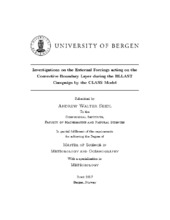Investigations on the External Forcings acting on the Convective Boundary Layer during the BLLAST Campaign by the CLASS Model
Master thesis
Permanent lenke
https://hdl.handle.net/1956/16069Utgivelsesdato
2017-06-20Metadata
Vis full innførselSamlinger
- Geophysical Institute [1187]
Sammendrag
Using both observed and modelled datasets from the 2011 Boundary Layer Late Afternoon and Sunset Turbulence (BLLAST) campaign, the influence of large-scale forcings and surface heterogeneity is investigated for ten out of twelve Intensive Observational Periods (IOPs) in order to assist and facilitate future research on this unique data set. This includes a categorisation of the individual IOPs according to the importance of horizontal advection and subsidence, as well as the sensitivity of the Boundary Layer (BL) development during those days to the time of initialisation. This is accomplished through the use of the Chemistry Land-surface Atmosphere Soil Slab (CLASS) model which is based on Mixed Layer theory. The study shows that neglecting large-scale forcings leads to considerable deviations between observed and modelled key parameters, such as BL height or average values of temperature and humidity, in nearly all of the investigated IOPs. In this context, only the simulations for IOP08 provided comparable results. In addition, for six out of the twelve IOPs, meso-scale simulations with MesoNH are available, with a horizontal resolution of 400 m. It is found that upon incorporation of those large-scale forcings from MesoNH, the Mixed Layer Model (MLM) simulations for IOPs 05 & 06 capture the observed trends closely. Furthermore, a novel concept of an averaging “box" domain is introduced for the treatment of surface heterogeneity in MLM theory. Using this concept, it is discovered that the BLLAST campaign area exhibits a “MLM blending length-scale" of approximately 5 km. Horizontally averaged surface fluxes on smaller scales depend on both the chosen domain size and the selected location (e.g. Site #1 or Site #2), whereby areal flux averages on larger scales become independent on the domain size.
